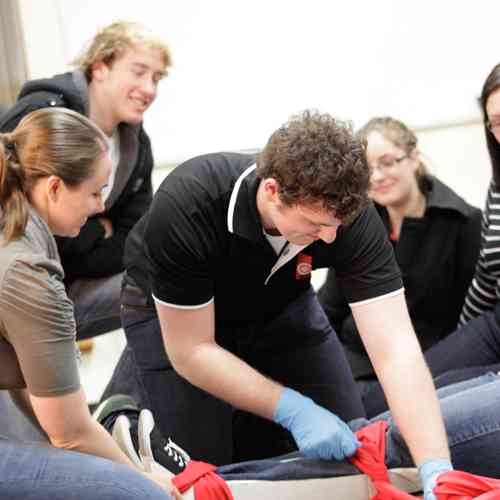Introduction
In our fast-paced world, emergency situations can strike without caution. Whether it's a minor injury, a medical emergency situation, or a dangerous situation, knowing just how to offer first aid can make all the distinction. This is where a First Aid course enters into play. Many people may wonder what they can obtain from such training, and this article intends to shed light on that.
By register in a First Help and CPR course, you do not simply find out about wrapping injuries or performing mouth-to-mouth resuscitation; you furnish on your own with vital skills that can conserve lives. So, what exactly will you find out in a thorough course? Let's study the details.
First Aid Basics: What You'll Discover in a Detailed Course
Understanding Initial Aid
What is First Aid?
First aid refers to the first support offered to somebody suffering from an injury or illness up until specialist medical assistance gets here. It includes different strategies and skills varying from basic wound care to lifesaving strategies like mouth-to-mouth resuscitation (Cardiopulmonary Resuscitation).
Importance of First Aid Training
Why Ought to You Take a First Aid Course?
Taking a First Aid course is vital for several reasons:
- Confidence: Understanding just how to react in emergencies can infuse confidence. Life-Saving Skills: The ability to perform CPR or aid with choking can save lives. Career Innovation: Many professions require accreditation in first aid. Community Responsibility: Learning means you can aid others effectively.
Overview of CPR
What is CPR?

CPR, or Cardiopulmonary Resuscitation, is an emergency situation procedure carried out when a person's heart beat or breathing has stopped. It combines chest compressions with rescue breaths to keep blood circulation and oxygenation up until professional aid arrives.
The Structure of a Comprehensive First Aid Course
What Does an Emergency treatment Course Include?
An all-round First Help and mouth-to-mouth resuscitation course usually covers the complying with subjects:
Introduction to First Aid Legal and Moral Considerations Scene Safety Basic Life Support (BLS) CPR Techniques Choking Relief Wound Treatment Management Burn Treatment Managing Shock Recognizing Medical Emergencies Using an Automated External Defibrillator (AED)Legal Facets of First Aid
Are There Legal Ramifications Associated With Giving First Aid?
Yes, offering emergency treatment does lug legal duties known as "Good Samaritan regulations." These legislations shield individuals that aid others in emergencies, supplied their actions are practical and not reckless.
Scene Safety: The Very First Step
How Do You Make sure Scene Safety?
Ensuring scene safety involves examining the setting prior to coming close to the sufferer:
- Look for potential dangers (website traffic, fire). Make sure it's secure for both you and the victim.
Basic Life Support (BLS)
What Function Does BLS Play in Emergency Situation Situations?
Basic Life Support consists of First Aid Course Sydney CBD the basics of maintaining life features till more medical help arrives. This area covers essential skills such as:
- Checking responsiveness Activating emergency situation services Performing high-grade chest compressions
Advanced mouth-to-mouth resuscitation Techniques
What Are Advanced Techniques Covered in Mouth-to-mouth Resuscitation Courses?
Advanced methods may consist of:
- Two-rescuer CPR Use of obstacle devices for rescue breaths Special factors to consider for infants and youngsters
Choking Relief Techniques
How Do You Assist Somebody Who is Choking?
Choking alleviation involves two essential techniques:
The Heimlich maneuver for adults. Back blows and chest drives for infants.Wound Care Management
How Do You Effectively Manage Wounds?
Effective injury management involves:
- Cleaning the injury with saline or clean water. Applying antibiotic ointment. Covering it with sterile dressings.
Burn Treatment
What Work Techniques for Dealing With Burns?
Burn therapy varies by level:

Cool the melt under running water. Cover it with non-stick dressings. Seek clinical focus for extreme cases.
Managing Shock
How Is Shock Recognized and Treated?
Recognizing shock consists of seeking symptoms like light skin, quick pulse, or confusion:
Lay the individual down. Elevate their legs unless there are injuries stopping this. Keep them soothe till aid arrives.Recognizing Medical Emergencies
What Sorts of Medical Emergencies Should You Be Aware Of?
Common medical emergencies include:
- Heart assaults Stroke Severe allergies Understanding these problems aids you act quickly.
Using an Automated External Defibrillator (AED)
How Do You Use an AED Correctly?
Using an AED entails turning it on, attaching pads according to illustrations on the device, and adhering to voice motivates carefully.

Importance of Continual Learning
Why Is Continuous Knowing Important in First Aid Training?
Continuous understanding guarantees you remain upgraded on ideal techniques and brand-new methods in emergency treatment care.
FAQs About First Aid Courses
What Is Included in a Standard First Aid Course?- A basic program typically covers fundamental life assistance, injury management, choking alleviation techniques, and lawful considerations.
- Most courses vary from 6 hours to 16 hours relying on the deepness of content covered.
- Yes, upon successful conclusion of the majority of programs, participants get a first aid certificate, which is usually valid for two years.
- Yes! Numerous companies provide online programs that supply adaptable discovering environments while still being effective.
- Absolutely! Hands-on technique is important for understanding abilities like chest compressions and utilizing AEDs effectively.
- Generally, there are no age limitations; nevertheless, individuals have to be psychologically qualified to discover these life-saving abilities effectively.
Conclusion
Enrolling in a detailed emergency treatment course gears up individuals with necessary knowledge that can conserve lives throughout emergency situations-- whether in your home, work, or out in public rooms! From understanding standard life support treatments such as CPR to learning just how to handle wounds effectively or recognize signs of shock-- these programs offer very useful training that anyone can benefit from!
As we browse through our lives full of changability-- what better way than preparing ourselves via understanding gotten from structured training sessions focused on conserving lives?
In final thought-- if you're pondering using up any type of form of first-aid training-- never ever think twice! Furnish yourself today with these powerful devices since readiness absolutely makes all the difference when every second counts!